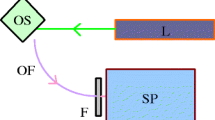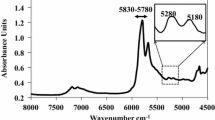Abstract
The adulteration of extra virgin olive oil (EVOO) with low quality edible oils is a major problem in the industry leading to economic frauds as well as customers’ health issues. A number of techniques have been used in the recent years for the characterization of extra virgin olive oil adulteration. In the current work, the spectroscopic techniques of absorption and fluorescence in combination with statistical analysis have been exploited to classify and quantify the adulteration of EVOO with different seed oils and pomace oil. The specific spectroscopic methods are rapid, with low cost and no sample pretreatment is required. The results of the present work indicate that both techniques are suitable for olive oil quality control, with absorption at visible region (400–800 nm) being superior for the specific number and types of oil samples. Specifically, visible absorption spectroscopy presents adulteration detection limits below 10%, a percentage within the range of commercial interest. The model accuracy of classification for the mixtures of adulterated oils is above 90%. For the first time, we present a facile method for obtaining simultaneously the amount of adulteration and the type of the adulterant in EVOO.




Similar content being viewed by others

References
Aparicio R, Harwood J (2013) Handbook of olive oil: analysis and properties. Springer, US
Bendini A, Cerretani L, Carrasco-pancorbo A et al (2007) Phenolic molecules in virgin olive oils: a survey of their sensory properties, health effects, antioxidant activity and analytical methods. An Overview of the Last Decade, pp 1679–1719. https://doi.org/10.3390/12081679
Christopoulou E, Lazaraki M, Komaitis M, Kaselimis K (2004) Effectiveness of determinations of fatty acids and triglycerides for the detection of adulteration of olive oils with vegetable oils. Food Chem 84:463–474. https://doi.org/10.1016/S0308-8146(03)00273-5
Clodoveo ML, Camposeo S, De Gennaro B et al (2014) In the ancient world, virgin olive oil was called “liquid gold” by Homer and “the great healer” by Hippocrates. Why has this mythic image been forgotten? Food Res Int 62:1062–1068. https://doi.org/10.1016/j.foodres.2014.05.034
Dankowska A, Małecka M (2009) Application of synchronous fluorescence spectroscopy for determination of extra virgin olive oil adulteration. Eur J Lipid Sci Technol 111:1233–1239. https://doi.org/10.1002/ejlt.200800295
Didham M, Truong VK, Chapman J, Cozzolino D (2020) Sensing the addition of vegetable oils to olive oil: the ability of UV–VIS and MIR spectroscopy coupled with chemometric analysis. Food Anal Methods 13:601–607. https://doi.org/10.1007/s12161-019-01680-8
Dourtoglou VG, Dourtoglou T, Antonopoulos A et al (2003) Detection of olive oil adulteration using principal component analysis applied on total and regio FA content. JAOCS, J Am Oil Chem Soc 80:203–208. https://doi.org/10.1007/s11746-003-0677-1
El-Abassy RM, Donfack P, Materny A (2009) Visible Raman spectroscopy for the discrimination of olive oils from different vegetable oils and the detection of adulteration. J Raman Spectrosc 40:1284–1289. https://doi.org/10.1002/jrs.2279
Fragaki G, Spyros A, Siragakis G et al (2005) Detection of extra virgin olive oil adulteration with lampante olive oil and refined olive oil using nuclear magnetic resonance spectroscopy and multivariate statistical analysis. J Agric Food Chem 53:2810–2816. https://doi.org/10.1021/jf040279t
Galtier O, Dupuy N, Le Dréau Y et al (2007) Geographic origins and compositions of virgin olive oils determinated by chemometric analysis of NIR spectra. Anal Chim Acta 595:136–144. https://doi.org/10.1016/j.aca.2007.02.033
Guimet F, Ferré J, Boqué R (2005) Rapid detection of olive-pomace oil adulteration in extra virgin olive oils from the protected denomination of origin “Siurana” using excitation-emission fluorescence spectroscopy and three-way methods of analysis. Anal Chim Acta 544:143–152. https://doi.org/10.1016/j.aca.2005.02.013
Heise HM, Damm U, Lampen P et al (2005) Spectral variable selection for partial least squares calibration applied to authentication and quantification of extra virgin olive oils using Fourier transform Raman spectroscopy. Appl Spectrosc 59:1286–1294. https://doi.org/10.1366/000370205774430927
Jabeur H, Zribi A, Makni J et al (2014) Detection of chemlali extra-virgin olive oil adulteration mixed with soybean oil, corn oil, and sunflower oil by using GC and HPLC. J Agric Food Chem 62:4893–4904. https://doi.org/10.1021/jf500571n
Jiang H, Chen Q (2019) Virgin olive oil using FT-NIR spectroscopy. Molecules 24(1–10):2134
Lazzerini C, Domenici V (2017) Pigments in extra-virgin olive oils produced in Tuscany (Italy) in Different years. Foods 6:25. https://doi.org/10.3390/foods6040025
Mavromoustakos T, Zervou M, Bonas G et al (2000) Novel analytical method to detect adulteration of virgin olive oil by other oils. JAOCS, J Am Oil Chem Soc 77:405–411. https://doi.org/10.1007/s11746-000-0065-x
Mendes TO, da Rocha RA, Porto BLS et al (2015) Quantification of extra-virgin olive oil adulteration with soybean oil: a comparative study of NIR, MIR, and Raman spectroscopy associated with chemometric approaches. Food Anal Methods 8:2339–2346. https://doi.org/10.1007/s12161-015-0121-y
Parkinson L, Keast R (2014) Oleocanthal, a phenolic derived from virgin olive oil: a review of the beneficial effects on inflammatory disease. Int J Mol Sci 15:12323–12334. https://doi.org/10.3390/ijms150712323
Passaloglou-Emmanouilidou S (1990) A comparative study of UV spectrophotometric methods for detection of olive oil adulteration by refined oils. Z Lebensm Unters Forsch 191:132–134. https://doi.org/10.1007/BF01202639
Philippidis A, Poulakis E, Papadaki A, Velegrakis M (2017) Comparative study using Raman and visible spectroscopy of Cretan extra virgin olive oil adulteration with sunflower oil. Anal Lett 50:1182–1195. https://doi.org/10.1080/00032719.2016.1208212
Poulli KI, Mousdis GA, Georgiou CA (2007) Rapid synchronous fluorescence method for virgin olive oil adulteration assessment. Food Chem 105:369–375. https://doi.org/10.1016/j.foodchem.2006.12.021
Psomiadou E, Tsimidou M (2001) Pigments in Greek virgin olive oils: occurrence and levels. J Sci Food Agric 81:640–647. https://doi.org/10.1002/jsfa.859
Torrecilla JS, Rojo E, Domínguez JC, Rodríguez F (2010) A novel method to quantify the adulteration of extra virgin olive oil with low-grade olive oils by UV-Vis. J Agric Food Chem 58:1679–1684. https://doi.org/10.1021/jf903308u
Vanstone N, Moore A, Martos P, Neethirajan S (2018) Detection of the adulteration of extra virgin olive oil by near-infrared spectroscopy and chemometric techniques. Food Qual Saf 2:189–198. https://doi.org/10.1093/fqsafe/fyy018
Westerhuis JA, van Velzen EJJ, Hoefsloot HCJ, Smilde AK (2010) Multivariate paired data analysis: multilevel PLSDA versus OPLSDA. Metabolomics 6:119–128. https://doi.org/10.1007/s11306-009-0185-z
Yang H, Irudayaraj J (2001) Comparison of near-infrared, Fourier transform-infrared, and Fourier transform-Raman methods for determining olive pomace oil adulteration in extra virgin olive oil. JAOCS, J Am Oil Chem Soc 78:889–895. https://doi.org/10.1007/s11746-001-0360-6
Yang Y, Ferro MD, Cavaco I, Liang Y (2013) Detection and identification of extra virgin olive oil adulteration by GC-MS combined with chemometrics. J Agric Food Chem 61:3693–3702. https://doi.org/10.1021/jf4000538
Zhang XF, Zou MQ, Qi XH et al (2011) Quantitative detection of adulterated olive oil by Raman spectroscopy and chemometrics. J Raman Spectrosc 42:1784–1788. https://doi.org/10.1002/jrs.2933
Acknowledgements
The authors would like to thank Ioulia Karagiannaki for her support in the optimization of statistical analysis results.
Author information
Authors and Affiliations
Contributions
Study conception and design by M. V. Material preparation, data collection and analysis were performed by G. S. and A. P. The first draft of the manuscript was written by G. S. and A. P. commented on previous versions of the manuscript. M. V. supervised the project and finalized the writing of the paper. All authors read and approved the final manuscript.
Corresponding author
Ethics declarations
Ethics approval and consent to participate
This article does not contain any studies with human or animal subjects. Informed consent was obtained from all individual participants included in the study.
Conflict of interest
The authors declare that they have no conflict of interest.
Giorgos Stavrakakis declares that he has no conflict of interest. Aggelos Philippidis declares that he has no conflict of interest. Michalis Velegrakis declares that he has no conflict of interest.
Additional information
Publisher's note
Springer Nature remains neutral with regard to jurisdictional claims in published maps and institutional affiliations.
Rights and permissions
About this article
Cite this article
Stavrakakis, G., Philippidis, A. & Velegrakis, M. Application of Optical Spectroscopic Techniques and Multivariate Statistical Analysis as a Method of Determining the Percentage and Type of Adulteration of Extra Virgin Olive Oil. Food Anal. Methods 15, 285–293 (2022). https://doi.org/10.1007/s12161-021-02055-8
Received:
Accepted:
Published:
Issue Date:
DOI: https://doi.org/10.1007/s12161-021-02055-8



